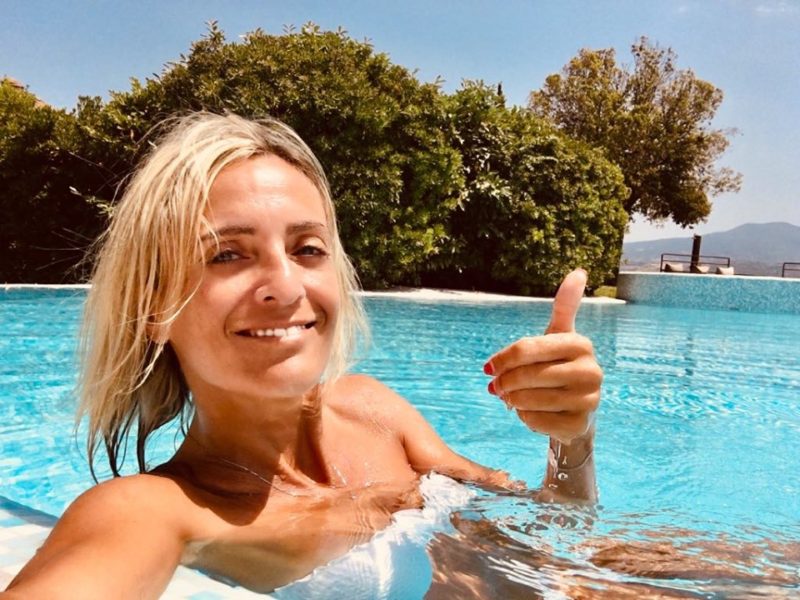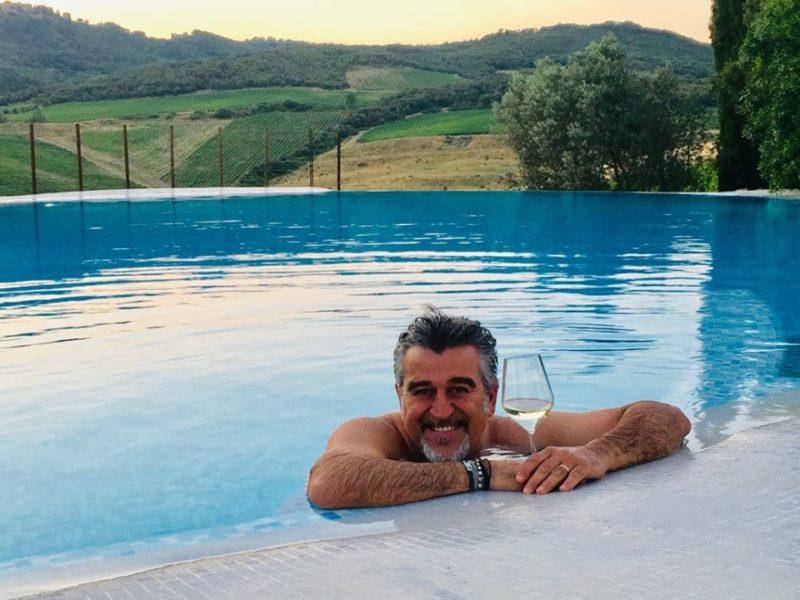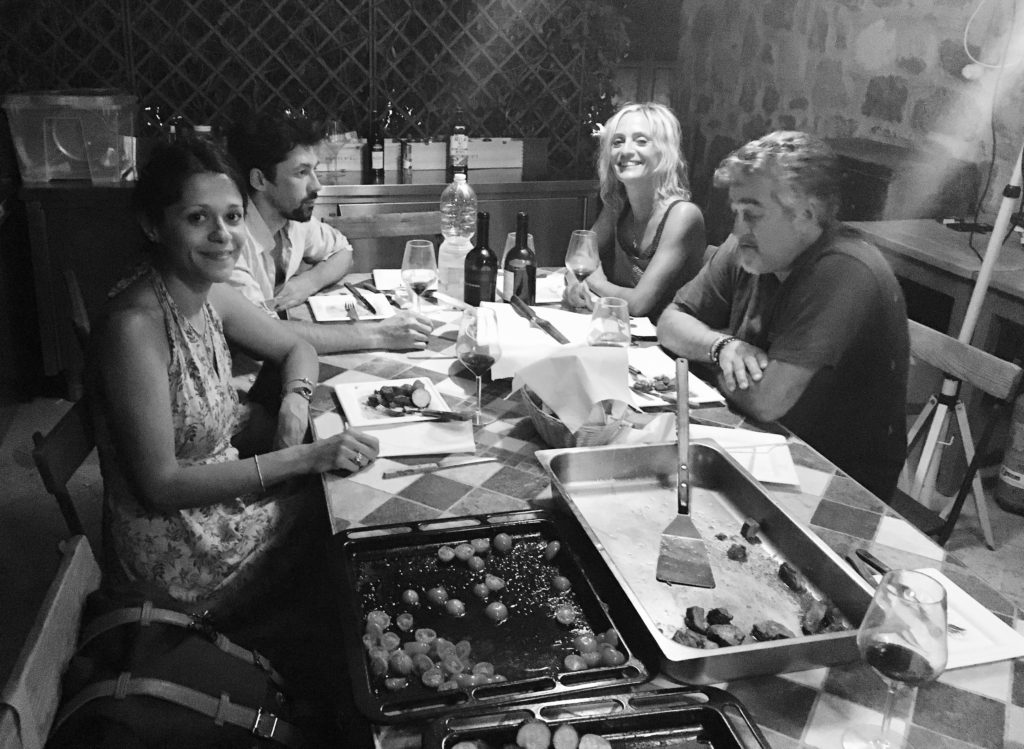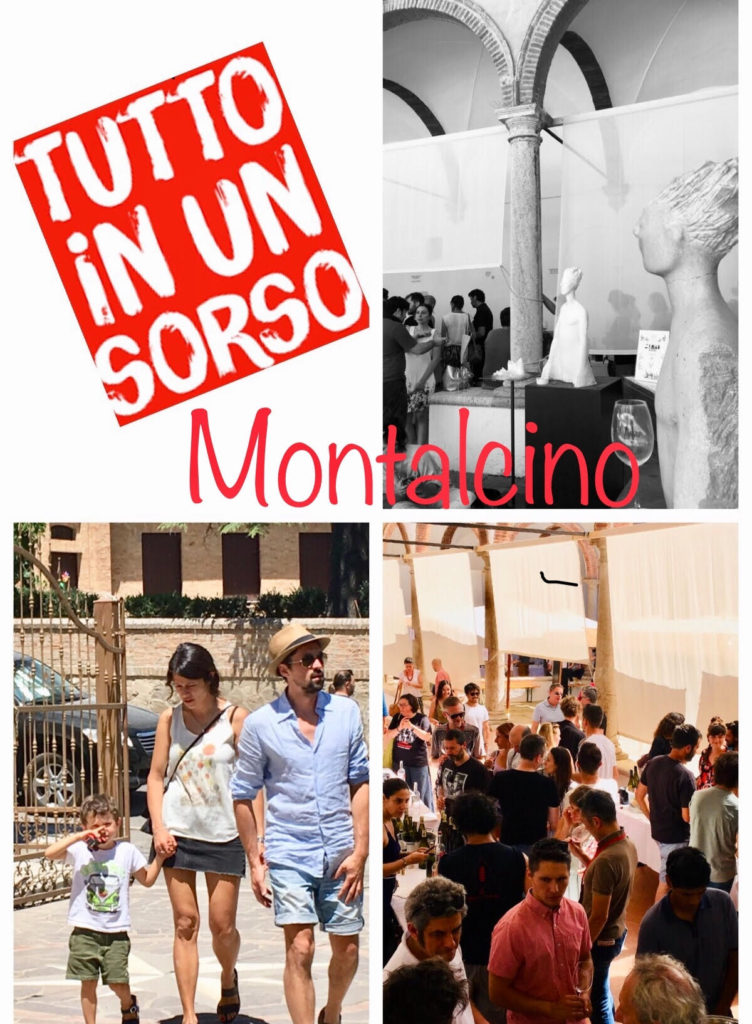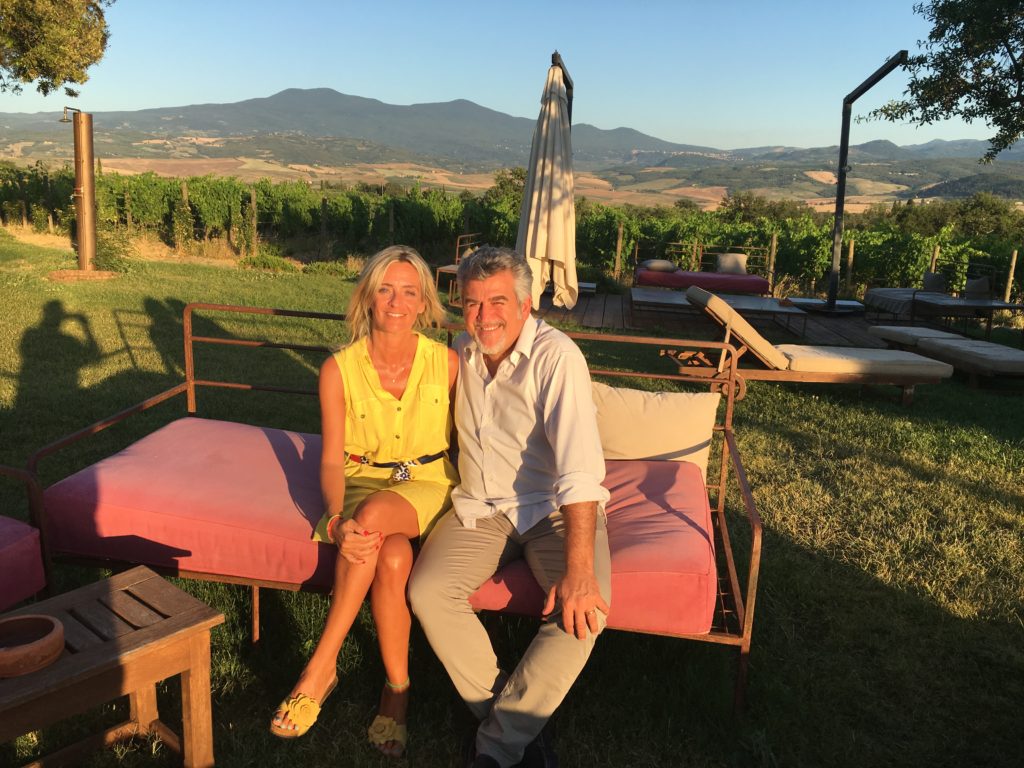“One’s destination is never a place, but a new way of seeing things.”
‘Bortolomiol winery’ . A weekend in Valdobbiadene, Veneto
On the first weekend of October I took a train from Pisa to Valdobbiadene, a quaint medieval village, located in the hills of Prosecco set in Veneto. It was my birthday! What a better present than leaving for Valdobbiadene for a special wine tasting at ‘Bortolomiol winery’ ! It was an original way to celebrate my date of birth, as Roberto Cipresso suggested with a call greeting!
Roberto Cipresso is my wine mentor and friend. He is a famous and talented international winemaker . At the age of twenty three, he moved from Bassano del Grappa to Montalcino, Tuscany, where he now lives with his family running his own winery ‘Cipresso 43’. The ‘Bortolomiol winery’ is one of the most prestigious wine companies Roberto deals with. It is also ine of the most representative of the ‘Prosecco area’ in Veneto, included in the ‘UNESCO’s World Heritage List ‘ in 2019.
If you like bubbles, you need an holiday in Veneto. Vineyards of Prosecco perch on the southern part of this region at a height between 50 and 500 meters above sea level. it’s useful to know for the wine experts that the most prestigious zone for the Prosecco production is Cartizze!
Veneto, is a perfect mix of environment and art, based on an efficient and widespread system of tourism and hospitality. All of this goes together with a remarkable variety and quality of great local products.
It is now time for me to share with you my unforgettable wine experience , which revealed yet another hidden Italian treasure, that is Veneto !
Veneto, the land of Prosecco
Veneto is a captivating Italian region, full of attractions, and renowned for its wine. All around are dotted small terraced vineyards planted on the steep slopes and almost exclusively dedicated to Prosecco, the most famous of Italy’s sparkling wines.
The Prosecco area is marvellous to visit at any time of year, though ideally between April and June, not only the weather mild, though also because there are many Prosecco-related events such as:
- ‘Vino in Villa’ ;
- ‘Primavera del Prosecco’ with fairs, markets, shows and exhibitions.
Today there are 8159 wine estates, 269 sparkling wine producers and around 200 million bottles produced. The Prosecco area includes 15 communes distributed between Conegliano and Valdobbiadene in the province of Treviso , which has extended into about 18 000 hectares of good quality agricultural land.
The beauty of Valdobbiadene
It was Friday . I arrived in Valdobbiadene in the late afternoon. After I entered my accommodation in ‘Piazza Marconi’, I unpacked, had a shower and then an aperitivo with some friends in a small though elegant cafè. The weather was just right for a stroll in the historic centre of Valdobbiadene.
Valdobbiadene has been inhabited for over forty thousand years and the first written documents there date back to 1116, when it was conquered by king Enrich V, and in the following centuries by Treviso, the ‘Ezzelini family’, Venice and Napoleon before finally being annexed by Italy in 1861.
What to see in the historic center of Valdobbiadene
Valdobbiadene may not be as popular as other cities in Italy though is a minuscule, charming tourist destination that is worth a visit. You will be surprised by some of the unique things you can do and the places you can explore.
Valdobbiadene is surrounded by important churches, castles and colourful Renaissance buildings aligned to the main Piazza Marconi , on which stands:
- A solitary bell tower : Francesco Maria Preti designed the tower, dating back to 1743 and completed in 1767. It was not completed until 1810, when the finishing touches were added to the distinctive, bulbous section at the top. Adorning the bell tower is a Sundial by the Abbot Giovanni Follador.
- ‘Santa Maria Assunta Cathedral’ : It was founded in the 12th century, but the current neoclassical building is the product of significant 18th century reconstruction work. Inside there are exquisite works of art by such illustrious names as Francesco Beccaruzi, Paris Bordon and Palma il Giovane.
On Saturday morning after a huge breakfast and a strong coffee, I went walking along the narrow rural streets of Valdobbiadene for a couple hours, immersing myself in nature and the green vineyards, whilst admiring the allure of autumn in the falling of leaves from the chestnut trees.
The sun was shining and I felt relaxed, simply wondering in contemplation prior to my first sip of Prosecco at the ‘Bortolomiol winery’.
What is Prosecco?
Prosecco is a sparkling white wine from Veneto, which is famous all over the world for its unique style and taste. Located in the North-Eastern part of Italy, Veneto is a small region, full of landscape of steep hills, which in turn create incredible flavours in its wines.
While consumers often equate it with widely available commercial-quality fizz, access to Italy’s finest sparkling wines is rising. Production techniques continue to improve, and the appetite for experimentation grows. The result is better bubbles and diminished sugar levels.
In the past, Prosecco and Glera were the thin-skinned green grapes used for making Prosecco , which grew in Veneto and Friuli Venezia Giulia in the Northern Italy for hundreds of years. But in 2009 due to an increased number of New World plantings, Italian authorities protected the name ‘Prosecco’ as a place of origin in a legal way , by rechristening the variety as Glera . ‘Conegliano Valdobbiadene’s appellation’ became a ‘DOCG’ in the same year!
History of Prosecco
Nowadays in Italy, the delightfully bubbly Prosecco pertains therefore to the historical village of Prosecco, a suburb of Trieste, close to Duino, where Glera grapes originated and had been cultivated since Roman times. Actually , Its name derives from the Slovenian word ‘prozek’ , which means ‘path through the woods’.
Romans used the Glera grapes to make a tasty drink called ‘Pucino’, which apparently was the life elixir of Livia, the second wife of the Roman Emperor Augustus, as stated by Pliny the Elder in his ‘Natural History’ ( First Century BC). Since then up until the 18th century the cultivation of the delicious Glera grapes has spread around Northern Italy.
Prosecco first and after the great Antonio Carpenè
The first written mention of Prosecco comes:
- In 1754 in the book ‘Il Roccolo Ditirambo’ by Aureliano Acanti, who wrote: “And now I would like to wet my mouth with that Prosecco with its apple bouquet”;
- In the 1800’s the academic Francesco Maria Malvolti referred to the quality of local winemaking in stating “thanks to varieties like Marzemini, Bianchetti, Prosecchi, Moscatelli, Malvasie, Glossari” . Malvolti also established the association between Prosecco and its region Conegliano Valdobbiadene.
Prosecco took its next major step forward when in 1868 Count Marco Giulio Balbi Valier cultivated a special grape variety he named ‘Prosecco Balbi’ . He published a booklet regarding his important research. Moreover, in 1876 ‘Conegliano’s School of Winemaking’ was founded, becoming a milestone for both the entire winemaking industry and education regarding wine.
The Romans may have enjoyed Prosecco, but it wasn’t until the 19th century when Antonio Carpenè subjected the still white wine to a second fermentation that Prosecco acquired its now lasting association with bubbles. Prosecco was going to be something major in the 20th century.
Prosecco DOC and DOCG
Until the years after World War II, almost all Prosecco was consumed locally, when it then grew beyond the borders of Veneto and Friuli-Venezia-Giulia, resulting in the production of inferior imitations to the point where wine producers formed a ‘Consortium’that would go on to create D.O.C.
Up until 2008, vintage Prosecco was protected in Italy as ‘D.O.C’. (‘Controlled Designation of Origin’), though in 2009 was upgraded to ‘D.O.C.G.’(‘Controlled Designation of Origin Guaranteed’).
The ‘Prosecco D.O.C.’ covers four provinces:
- In Friuli-Venezia-Giulia (Gorizia, Pordenone, Udine, and Trieste);
- And five in Veneto (Padua, Venice, Treviso, Vicenza, and Belluno);
- Two D.O.C.G’s. fall within the D.O.C.: ‘Prosecco Conegliano Valdobbiadene Superiore D.O.C.G.’ and ‘Asolo Prosecco Superiore D.O.C.G.’.
For the first, the wines are harvested on the hills between the two eponymous towns, while the latter is produced from its namesake town and is known for its exclusive extra-brut vintage (up to 6 grams of residual sugar per liter). The hills where the wine is cultivated are so steep that the vineyards can only be worked by hand, which only adds to the value of the wine. It should come as no surprise that it is also a lovely place to visit.
Prosecco versus Champagne
In recent years, Prosecco has become very popular, especially in the UK. According to current figures, Britons spent more money in supermarkets over the holidays on Prosecco than on Champagne. It is a big affair for an appellation that didn’t even formally exist until 2009 as the shortage of Prosecco in 2017 upset wine lovers across the globe!
Prosecco is getting more and more popular, probably because it is a luxury product like Champagne but has a much affordable price! Both Champagne and Prosecco are sparkling wines, though the similarities end there!
Do you know the difference between Prosecco and Champagne?
Is Prosecco Champagne? The quick answer is simple:
- First thing, Champagne is a sparkling wine produced in the region of Champagne in France, which is about 80 miles (130 km) Northeast of Paris. Only Champagne can be called Champagne !;
- Prosecco is produced in the regions of Veneto and Friuli-Venezia-Giuliaclose to Treviso which is about 15 miles (24 km) North of Venice.
14 main differences between Prosecco and Champagne
But there’s more than just the name . Let’s go deeper into these differences as regards their terroir, composition, output, flavour, tasting notes, aging, calories, and price:
- Champagne encompasses a patchwork of soils endowed with unique characteristics such as the presence of chalk and limestone;
- Prosecco grapes are harvested on steep, mostly chalk and limestone hills west of Venice and north of Valpolicella, with traces of clay, marl and marine sandstone. These hills are situated between the Dolomite mountains and the Adriatic Sea. This is a perfect position with a mild climate and plenty of annual rainfall;
- Champagne can be made as a blend or from a single varietal wine predominantly from Chardonnay, Pinot Noir and Pinot Meunier ;
- Prosecco is made primarily from Glera grapes;
- Champagne is made using a high-priced method known as the ‘méthode champenoise’ or ‘traditional method’, which happens in the bottle, releasing complexity, texture and flavours;
- Prosecco undergoes the cheap and fast ‘tank method’ , meaning that the second fermentation happens in a single large tank.
- Prosecco tends to be a little sweeter than Champagne ;
- Champagne‘s primary flavours are citrus, white peach and cherry, almond and toast;
- Prosecco’s primary flavours are green apple, honeydew, honeysuckle, pear and fresh cream;
- Unlike Champagne, Prosecco should be consumed young as it doesn’t benefit from bottle aging;
- A standard 5 oz serving of Brut Champagne has 91–98 calories and 1.8 g of carbohydrates (12% ABV);
- A standard 5 oz serving of Extra-Dry Prosecco has 91–98 calories and 2.6 carbohydrates (11% ABV);
- A good-quality bottle of Champagne can cost between € 50 and € 300- whilst vintage bottles are sold for thousands of euros;
- A bottle of Prosecco can cost as little as $12.
Is better Champagne or Prosecco? It’s not a question of price , and Champagne cannot be the winner in this debate because costs much more (It is a lot more time intensive to produce and thus, more expensive1) than Prosecco. Both types of wine are unique and offer different kinds of tasting experience. If you want to understand better, consider purchasing a bottle or two of each kind to help you decide which one you prefer!
‘Bortolomiol Winery’, a beating heart in the hills Conegliano and Valdobbiadene
The family-run Prosecco ‘Bortolomiol winery’ lies in between the hills of Conegliano and Valdobbiadene, the territory of the ‘Prosecco Superiore D.O.C.G.’, where it has been based since 1949. Here are the most prized vineyards for the production of this great sparkling wine, because the steep slopes make it difficult to mechanize the work traditional methods that are more than 200 years old are still used by growers in these hills today.
Conegliano and Valdobbiadene are at opposite ends of the region of Veneto, the first to the east the second to the west. With their different and varying microclimates, complex geologic history, and dedicated winemakers, both came to produce world-class sparkling wine.
The terroir of Conegliano and Valdobbiadene
Conegliano is the site of Italy’s first winemaking school which opened in 1876, the lands around lands around it carved by glaciers, which smoothed the rocky edges into rolling hills and left deep mineral deposits in the soil. The soil here is a mix of clay, stones, and sand, which yields grapes with more sugar and consequently wine with a persistent and intense fruity and floral aroma even with spicy notes.
Valdobbiadene‘s hills in the west are by contrast rugged and steep. The soil here comes partly from ancient sea beds, a mix of marlstone, sandstone, and clay. Wines made from grapes grown in this area tend to be more floral while fruit elements can vary from citrus to sweeter white fruits.
‘Prosecco and Conegliano Valdobbiadene hills wine route’
The two capitals are also the place where the first Italian wine route was introduced in 1966, now known as the ‘Prosecco and Conegliano Valdobbiadene hills wine route’. It is a circular itinerary spanning approximately 90 km, which offers visitors the opportunity to explore traces of the local rural, civil and religious history , such as awesome vineyards, medieval hamlets, churches and castles.
Cartizze
Cartizze is an even more exclusive sub-designation of the ‘Prosecco Conegliano Valdobbiadene Superiore D.O.C.G.’, one of the finest versions of Prosecco. The steep hill is known as the grand cru’ covering about 107 hectares of the region.
For producers in Prosecco, Cartizze is the most honoured area in the region and has witnessed unprecedented popularity all around the world. This south-facing hilly chain is always exposed to the sun, yet constantly catches a breeze from the north-east as well as cold air from the Alps at night which enhances the flavour of the grapes.
Conegliano
The marlstone-sandstone soil here is old, but not as deep as that around Conegliano. The highest-quality and most sought-after wines come from this part of the D.O.C.G. region, partly because of the unique growing conditions created by the terrain.
The tricky landscape is one of the reasons for the high quality of the grapes, as the steep slopes mean excellent drainage that keeps the vines healthy. The grapes that grow in Cartizze produce wines that are predominantly floral rather than fruity, and usually are made dry (which is the sweet end of the Prosecco scale).

Welcome at ‘Bortolomiol winery’. One day to experience the real venetian Prosecco
Saturday, 11 o’clock. Valdobbiadene woke up after a cold windy night with people crowded all around the streets and inside the shops. I went into a tourist office to ask for information as to how to get to the ‘Bortolomiol winery’. As it was ten minutes on foot from the historic centre, I decided to go there earlier than my booking at 14:30 !I rang the bell at the gate, and not a soul was in sight !
After a while and to my relief, a tall, smart man came and welcomed me. It was Diego, who is responsible for the guest relation service. I tried to change the scheduled time of my tour, but he said he could not satisfy my request because it was against company policy. I was so sorry ! Suddenly, he made a sign for me to go inside the winery and to wait for him there.
I opened the brass handled door and fell in love with the big and smart tasting room full of visitors and great Prosecco labels. I sat on a comfortable red sofa and whilst I was reading a magazine, a polite and pretty hostess offered me a glass of a fresh dry white wine. After having greeted his last clients, Diego came close enough to me so that he was certain that no one else could hear him while he attended to my needs.
‘Bortolomiol winery’ , a jewellery nested in the ‘Filandeta park’
First, Diego was really kind to invite me to lunch at the winery , charming my palate with hand-made bread , parmesan and ham paired of course with Prosecco! After lunch , he showed me a map of ‘Filandeta park’, which is home to the ‘Bortolomiol winery’, where he suggested going for a walk before my official tasting at ‘Bortolomiol winery’ in the afternoon!
I said thank for being so kind , then I headed toward ‘Filandeta park’ next to the bell tower of Valdobbiadene. This huge wood was once a silkworm factory, which was bought and restored by the Bortolomiols as part of their business. The Bortolomiols have contributed significantly not only to the culture and economy of Valdobbiadene . They have also created a corner of paradise inside the municipality, a green space placed at the disposal of all citizens and any pilgrim, who wants to be involved in the real food and wine heritage of Northern Italy.
The ‘Bortolomiol winery’ is located exactly in the centre of Valdobbiadene surrounded by its vineyards inside the stunning ‘Filandeta park’ . It is an open-air wine & arts area, hosting an incredible artwork collection by Giovanni Casellato and Susken Rosenthal.
There was a connection between their modern and abstract statues, illustrating the concept of freedom. Reading the plaques adorning these statues, all these sculptures are made of different materials and are a symbol of life and nature.
The history of the Bortolomiol family
I appreciated a lot of what was around me, everything seemed to fall right into place. As the sky was turning grey and the air was getting progressively colder, I went back to the winery. I learnt a lot about the history of the Bortolomiol family by scanning the inner descriptive panels and black and white photos that hung on the walls of that magnificent building. It goes like this!
Giuliano Bortolomiol founded the winery in 1949. His father passed on to him a strong passion for wine and the values of countryside. Giuliano was very young when he decided to attend the prestigious ‘Conegliano Wine School’. Soon after the Second World War, he decided that he wanted to realize an oenological rebirth in his homeland.
Thanks to an improvement in production and quality of Prosecco, he has created his own brand of a new prestigious Italian sparkling wine which would be become known throughout the world. Having obtained the ‘D.O.C.G. designation’, his dream has come true and ‘Prosecco Superiore’, has become a wine beloved at international level.
Maria Elena, Elvira, Luisa and Giuliana . The new generation of the Bortolomiol family
However, the winery owes its growth to his four daughters, Maria Elena, Elvira, Luisa, and Giuliana, who today together with their mother Ottavia run business with professionalism. In their father’s memory the four sisters made the ‘Cuvée Del Fondatore’, which is one of their best Prosecco .
‘Cuvée Del Fondatore’ is a ‘Valdobbiadene D.O.C.G. Prosecco Superiore Brut’ made from a single-vineyard cultivated in San Pietro di Barbozza. However, what has set the Bortolomiol family apart is simply their love and their intense dedication to what they have done and still do . Their principles have remained unaltered since its founding, producing high quality products and supporting the promotion of their territory.
The Bortolomiols also supports humanitarian projects in Africa such as those representing women rights and the fight against AIDS. Two centuries of tradition lie at the heart of the Bortolomiol family’s understanding and vocation for wine-making in Valdobbiadene. They interpret the varieties used to make their wine in the best possible way, planting the steep hills with hand-tended vineyards. They develope also a wine making process to enhance the aromatic characteristics , elegance, freshness and vitality, which has made their brand stand out.
The Glera grape variety has found an ideal environment in these hills. It is in fact in this area that the variety has always performed at its best and it is from here that universally recognized quality has developed, the cutting edge of which is ‘Superiore di Cartize’.
A top Tasting at ‘Bortolomiol winery’
There’s nothing better and more unconventional than enjoying a glass of classy Prosecco in front of a fireplace in the lush open spaces at ‘Bortolomiol winery’ on a rainy autumn afternoon. Visiting the ‘‘Bortolomiol winery’ means that you give yourself the best opportunity of having a fantastic holiday discovering Veneto and tasting some of the finest Prosecco varieties on offer.
Tasting Prosecco in that elegant room in the ‘Bortolomiol winery’ was really like being in a fairy tale. At two o’ clock a sommelier entertained us showing us a video regarding the history of the denomination. Moreover, the video tell us about the land and how the whole family exploited their talent for winemaking from their beginnings to current days.
Prosecco, the sparkling wine from North Italy . Seduction in a simple way
Later the young wine expert informed us of some interesting detailed facts regarding Prosecco:
- Proper Prosecco must be made with at least 85% Glera grape and now must be grown in UNESCO designated areas. Other grapes commonly added to Glera include native varieties, such as Verdiso, Bianchetta Trevigiana, Perera, Glera Lunga and international grapes, such as Chardonnay, Pinot Bianco and Pinot Grigio;
- The very best Prosecco has the ‘D.O. C.G.’ signifier;
- While iconic Prosecco are sparkling, both the ‘D. O.C.’ and ‘D.O.C.G.’ versions can be made in sparkling, semi-sparkling and even still versions;
- Unlike Champagne and other red and white wines, Prosecco is a young wine that doesn’t like to be aged. By the way, recently a new version of Prosecco known locally as ‘col fondo’ has been launched onto the market. It is a Prosecco refermented in the bottle, whose yeasts accumulate at the bottom (‘il fondo’ in Italian) producing a layer of sediment, that gives the wine a fragrant bread crust aroma;
- Prosecco should be served cold in a tulip glass, as this design allows a little more space for easy swirling of the wine, and focuses the aromatic notes towards the nose;
- Prosecco is one of the most versatile wines around. It is ideal for drinking at breakfast along with scrambled eggs, a sweet tipple in the afternoon to be served with pastries and as a salty aperitivo or with a variety of dinners.
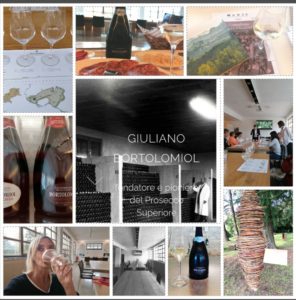
Best labels of the ‘Bortolomiol winery’
After my tasting of Prosecco at the ‘Bortolomiol winery’, I realized that there is so much more to Prosecco than just reasonably priced bubbles! It is not only the favourite aperitivo for Italians up and down the peninsula, though nowadays is also the most sold sparkling wine in the U.S. Why? Because Prosecco is refreshing, flavourful, light-bodied, and (usually) dry.
It is my pleasure to list below the best labels I discovered during my wine tasting at the ‘Bortolomiol winery’:
- ‘Bandarossa Valdobbiadene DOCG Prosecco Superiore Extra Dry Millesimato’: It is the Italian for ‘red band’. Since 1986 Giuliano Bortolomiol has put this mark on bottles containing the best ‘extra dry’ of the year to be consumed with close friends, and today this band indicates wines of a high standard. It is delicate sparkling wine, with a nose and fragrance of mature yellow apple with scents of sweet citrus and flower hints. Its perlage is fine. On the palate it is slightly sweet and creamy balanced by a nice acidity. It is perfect as an aperitivo and for serving with any pleasant and savoury dish such as mozzarella with marinated anchovies, marinated fish and stuffed artichoke;
- ‘Superiore di Cartize’: The Cartizze hill is a genuine Grand Cru. It is a fragrant sparkling wine with a gentle and persistent perlage. It has a nose with an aroma of exotic fruit, hazelnuts and sweet acacia flowers. On the palate sugars are balanced, having a freshness, notable density and creaminess. This is a wine for special occasions which can be enjoyed on its own or as the perfect accompaniment to fine desserts;
- ‘Extra brut Riserva del Governatore’: it is a kind of Charmat made from Pinot Noir and Chardonnay It is a very refined and dry sparkling wine. It is quite aromatic, crispy, of medium body with a long last. It goes perfectly with rich fried meat and fish dishes;
- ‘Filanda Rosé’: Giuliano made his first rosé in the 1970’s, and his four daughters together with their mother made this rosé great, dedicating this wine to the noble women who worked in the Valdobbiadene silk mills, improving the whole area from anybody’s point of view. This wine is made from Pinot Noir of the Oltrepò Pavese – north west Italy. It is light pink in Its bouquet is fruity, complex, and floral. It has a nose that is spicy. In the mouth it is fragrant with a good body. It pairs well with exotic and tasty food;
- ‘Canto Fermo Valdobbiadene Prosecco D.O.C.G. Tranquillo’: it is a non-sparkling Prosecco, basically a white wine made out of Glera grapes, traditional and very specific to the region. This ‘Prosecco D.O.C. Tranquillo’ offers a different kind of pleasure, more reflective and genuine. In contrast to the sparkling and semi-sparkling versions, ‘Prosecco Tranquillo’ has no carbon dioxide or residual sugars. It is fragrant, fruity fine and very tasty. Pairing foods: all kinds of fish, above all the more delicate dishes.
Prosecco for modern cocktails and venetian recipes
There’s a whole lot you don’t know about Prosecco, from its fascinating history to the rare varieties and the best ways to drink it. For example, Prosecco is a key ingredient in some worldwide known cocktails:
Prosecco goes incredibly well with many Italian dishes and menus. Of course you’ll find Prosecco in lot of venetian farmhouses, shops, and restaurants. Before going back to Pisa, I had a dinner in an intimate bistrò in Valdobbiadene , where I had Prosecco paired with:
- An appetizer of succulent ‘crostini’ seasoned with ‘sorpressa’ , which is a traditional cured meat with spices and garlic added to it;
- The highly acclaimed ‘risotto con radicchio di Treviso’, which is rise stuffed with a lettuce leaf with a unique bitter taste, that can be used and cooked in countless ways.
Are you hungry? If your answer is yes, hurry up, and start planning your upcoming trip. Veneto is still a relatively unknown area, which attracts many visitors keen to admire its beauty and who also want to find out more about this fantastic Italian wine region. Make sure you get there first for an authentic experience like the one I had!
If you like my post, please subscribe to the socials of www.WeLoveitaly.eu :





